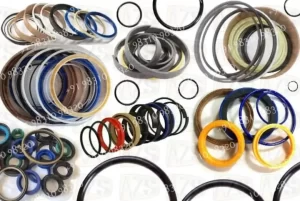Hydraulic cylinders are the workhorses of countless machines and industrial applications. Their ability to convert pressurized fluid into powerful linear motion drives everything from construction equipment to manufacturing robots. But for a hydraulic cylinder to function efficiently and reliably, a critical component plays a behind-the-scenes role: seals.

Hydraulic cylinder seals are specialized components that form tight barriers between different parts of the cylinder. These seals prevent leaks, contamination, and friction, ensuring the smooth operation of the system. This guide dives deep into the world of hydraulic cylinder seals, exploring their types, materials, functions, selection factors, and maintenance practices.
Types of Hydraulic Cylinder Seals
The diverse applications of hydraulic cylinders necessitate a variety of seal designs to address specific needs. Here’s a breakdown of the most common types:
-
Piston Seals: These vital seals form the primary barrier between the high-pressure fluid in the cylinder bore and the low-pressure area behind the piston. They are typically dynamic seals, meaning they constantly move against the cylinder bore as the piston extends and retracts. Common piston seal designs include:
- U-cups: Simple and versatile, U-cups have a single sealing lip that contacts the bore.
- T-seals: Featuring a T-shaped cross-section, T-seals offer superior sealing performance at high pressures.
- Chevron seals: With multiple sealing lips arranged in a chevron pattern, these seals excel in high-pressure applications with minimal friction.
-
Rod Seals: Installed at the point where the piston rod exits the cylinder, rod seals prevent fluid leakage and guard against external contaminants entering the system. These are also dynamic seals, constantly in contact with the moving rod. Popular rod seal designs include:
- Scraper seals: These single-lip seals remove dirt and debris from the rod before it reaches the primary sealing element.
- Wiper seals: Often made of fabric or polyurethane, wiper seals wipe away contaminants while offering minimal friction.
- Rod packings: Combining multiple sealing elements, rod packings provide high sealing effectiveness for demanding applications.
-
Buffer Seals: Located between the piston and the rod seal, buffer seals dampen pressure spikes and vibrations during rapid piston movement. They can be static (no movement) or dynamic depending on the design.
-
Guide Rings: These wear rings minimize friction between the piston and cylinder bore, ensuring smooth operation and extending cylinder life.
-
O-rings: Simple yet effective, O-rings are used for static sealing applications throughout the hydraulic system, creating a tight seal between stationary components.
Materials for Hydraulic Cylinder Seals
The choice of material for a hydraulic cylinder seal is crucial for its performance and lifespan. Factors like operating pressure, temperature, fluid type, and wear resistance all come into play. Common seal materials include:
- Nitrile Rubber (NBR): A cost-effective and versatile material suitable for moderate pressures, temperatures, and petroleum-based fluids.
- Polyurethane (PU): Offering superior wear resistance and wider temperature tolerance compared to NBR, PU seals are well-suited for demanding applications.
- Fluorocarbon (FKM): Known for excellent chemical resistance and high-temperature performance, FKM seals are ideal for harsh environments with aggressive fluids.
- Polytetrafluoroethylene (PTFE): With incredibly low friction and broad chemical compatibility, PTFE seals are often used in low-pressure applications or when minimal friction is critical.
Functions of Hydraulic Cylinder Seals
Hydraulic cylinder seals perform several vital functions within the system:
- Preventing Leaks: Seals create a barrier between high and low-pressure areas, ensuring that hydraulic fluid stays where it belongs and doesn’t leak out, compromising system efficiency and potentially creating safety hazards.
- Excluding Contaminants: Seals prevent dirt, dust, and other external contaminants from entering the hydraulic system. Contamination can accelerate wear, lead to component malfunction, and shorten cylinder life.
- Minimizing Friction: Seals are designed to create a tight seal while offering minimal friction between moving components. This ensures smooth operation and maximizes the efficiency of the hydraulic system.
- Maintaining Pressure: Seals play a crucial role in maintaining system pressure by preventing leakage. Consistent pressure is essential for the cylinder to generate the desired force and perform its intended function.
Selecting the Right Hydraulic Cylinder Seal
Choosing the right seal for a hydraulic cylinder application requires careful consideration of several factors:
- Operating Conditions: Pressure, temperature, and fluid type all play a significant role. Select a material compatible with the fluid and capable of withstanding the operating pressures and temperatures.
- Movement Type: Seals come in dynamic and static varieties. Choose the appropriate type based on whether the seal will be in constant contact with a moving component.
- Application Requirements: Consider factors like wear resistance, friction, etc
